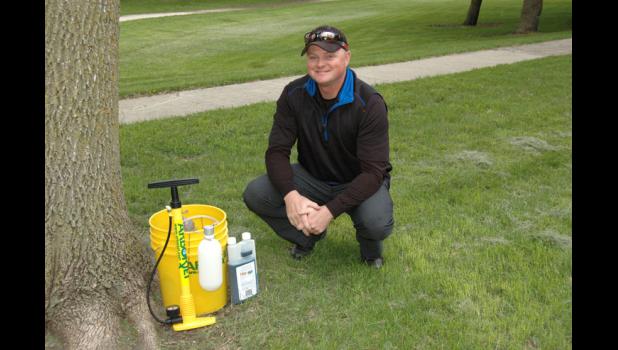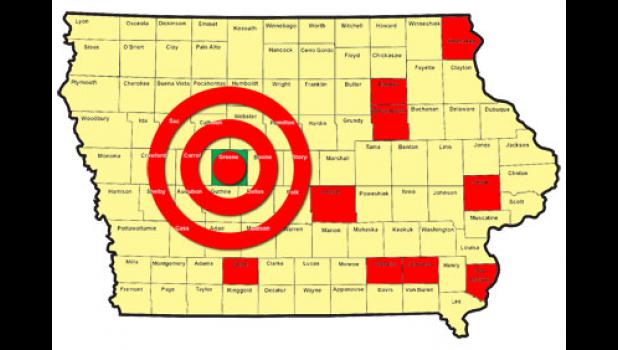‘It’s coming’
By MAKAYLA TENDALL
m.tendall@beeherald.com
The Emerald Ash Borer has descended upon the Midwest, tearing up and devastating tree populations like a plague out of the Bible.
City officials and owners of Ash trees are weighing options in preparation of the beetle’s imminent arrival in Greene County.
What is EAB and what is it doing?
The beetle has already devastated portions of the Midwest and has been spotted in nine Iowa counties as close as Union and Jasper counties.
“It’s basically jumped from one county to nine counties in the last 12 months,” said Michael Cooley, Iowa State University Extension coordinator for Greene County. “The Emerald Ash Borer’s lifespan is really about a year, so it shouldn’t be able to spread more than three miles a year.
“It really should take it about 30 years to get as far as it did.”
The Emerald Ash Borer is a beetle — small enough to fit on the face of a penny — which originated in Asia and was carried to North America on the wood of shipping crates.
The beetle will only attack Ash trees.
The EAB lays its larvae on the bark of the tree, and when the larvae hatches in one or two weeks, it will gnaw through the bark and feed on the wood.
The process cuts off the flow of nutrients and water from cell to cell and kills the tree in three to six years.
“When it emerges, the beetle flies to the top of the tree, eats the leaves and when it comes time to lay eggs, it lays its own eggs and the next generation goes in and back and forth,” Cooley said.
The small green beetle traveled from Canada to Michigan, where it annihilated the Ash tree population, and began to spread across the Midwest.
Cooley said the EAB population went unchecked for so long because there has been little research on the beetle.
It never posed a problem to Ash trees in Asia because they’re immune.
“Basically, with anything, as things develop together, they kind of become immune to each other,” Cooley said about Asian Ash trees having evolved to coexist with the EAB. “The Ash trees here are not immune to it. Now people are researching it.”
Cooley also said there are natural predators of the beetle in Asia, such as a species of wasp, which helps keep the population down.
However, experiments with wasps that are underway in Michigan have only been successful in curbing 30 percent of the population. Woodpeckers would take care of another 20 percent of the EAB population.
“We can at least cut them in half, but it’s still not going to help. The Emerald Ash Borers are still way ahead,” Cooley said.
The population largely spread across the Midwest rapidly because of human movement, namely the movement of infested firewood from state to state. The state of Iowa is under quarantine, meaning it’s illegal to carry firewood across state borders.
The biggest problem with the EAB zipping across the Midwest is that it takes two to three years to identify an infestation, leaving many Ash tree owners to wonder how to combat the onslaught of small green beetles.
Treatment
There are three options for treatment, said Jay Goughnour, a 1995 graduate of Jefferson-Scranton High School who now works as a customer service representative for John Deere Landscapes.
John Deere distributes treatment options.
Goughnour said the first option would be to “do absolutely nothing,” and when the EAB arrives in Greene County, trees will die and will need to be cut down.
Goughnour said the cost of cutting down a tree costs between $750 and $1,200 per tree.
Ash trees will need to be cut down soon after they die because they become a safety hazard, evident in cities such as Chicago where there are almost no untreated, live Ash trees left.
“When they die, they get very, very brittle. When that tree dies, you can’t climb them unless you have a death wish because it will just break apart,” Goughnour said. “When you drop those trees, when they fall, they will literally shatter, and we’ve got plenty of reports where that’s a problem.
“It’s shooting branches into cars and into windows.”
Goughnour said the trees will splinter into pieces small enough that it’s difficult for cleanup and labor costs increase because of the damage done.
Cooley said that besides an aesthetic value, trees do have a value of up to $75 a year as added shade or a windbreak if near a house.
A second option would be to remove Ash trees immediately before the pests arrive.
“I don’t agree with that one. I just say enjoy the tree while you’ve got it. There’s no reason to cut down a healthy Ash tree,” Goughnour said.
Cooley said that before cities and homeowners decide to remove trees, they must look to see if the tree is unhealthy enough to deserve removal, and if the tree works in the location and landscaping it’s already planted in.
If the homeowner knows they don’t want to treat trees with a pesticide, Cooley recommended planting another species of tree near an Ash tree so the tree already has some growth when the Ash needs to be removed.
The third option is to treat Ash trees.
Cooley recommended treating trees when the EAB has been sighted within 15 miles because he said research shows it’s not beneficial to treat trees any sooner.
Goughnour said he does not agree with the recommendation.
He said the beetle is extremely hard to detect in the first place, and the EAB could already have infested a tree 15 miles away from where it has been discovered.
Treatments include bark sprays that Goughnour and Cooley say are not as effective because it only works in the spring, harms other prized insects such as bees, and is easy to apply but is difficult to mix with the right dosage of pesticide. Bark sprays also have a per acre restriction, meaning only a certain amount is legal to use in a certain distance and not all Ash trees may be treated.
Soil drenches, where pesticide is mixed with water and spread near the base of the roots, is only effective in the spring as well. They also have a per-acre use requirement.
Goughnour said the real prize lays with Tree-age, a chemical manufactured by Arborjet Inc.
The chemical is used by injecting only a few ounces into the trunk. The hole is then sealed with a small plastic plug that Goughnour said acts as a regular knot in the wood as the tree grows around it.
Tree-age is both preventative and curative, Goughnour said, meaning that it both protects the tree and combats infestations if the tree has 30 percent or less canopy loss from lack of circulation.
“The university studies behind it are showing that it’s about a 99-percent effectiveness. It’s virtually a silver bullet. The one percent is usually due to operator error,” Goughnour said.
The treatment lasts for two years, and the hired treatment costs about $10 to $12 an inch, Goughnour said.
“The cost of treatment is a fraction of what it would cost to remove a tree. You can treat a tree for a decade or more for less money than what it would cost to cut it down,” Goughnour said.
Goughnour said the Arborjet website provides a calculator for homeowners to see what it would cost them to treat however many trees they want to treat.
Importance of a plan
“It’s going to sneak up on them quick, and when it gets bad, it’s going to get really bad,” Goughnour said about the EAB spread.
Carole Fisher, a member of the Jefferson Tree Committee, said she hopes homeowners take notice and try to save trees, but she said most “probably wouldn’t spend that kind of money” that it takes to treat trees.
Fisher said those who genuinely care about trees, such as herself, will take preventative action.
“When I first moved here, I was 12 years old, and I’m now almost 80. The thing I noticed — and was so enthralled with — was the canopy the Elm trees provided over the streets,” Fisher said. “Maybe some people don’t notice, but as a 12-year-old, I noticed.
“When the trees died, it just changed the whole atmosphere of Jefferson.”
Mike Palmer, Jefferson city administrator, said the city has not made plans yet but is determining whether they will use treatment or begin cutting down Ash trees.
“At this point, we’re going to the informational classes,” Palmer said. “We want to give it a little bit more time to see what the best option would be for us.”
Cooley also said homeowners need to be aware of the need for a diverse population of trees when they begin planting new trees so that another disease doesn’t wipe out a large population.
Goughnour said that homeowners now need to take inventory of their Ash trees and determine which are worth saving and which are not.
He said that not every tree needs to be saved, but a plan is necessary nonetheless.
“It’s coming,” Goughnour said about the EAB. “It’s coming.”
What to look for in Ash trees
• Unusual sprouting at the base: The tree tries to save itself in the beginning and sends up sprouts to compensate for the dying parts.
• Canopy thinning: The leaves don’t receive the supply of water or nutrients and begin to die.
• Woodpecker damage: Woodpeckers will peel back portions of bark to eat the beetle.
- Log in to post comments




